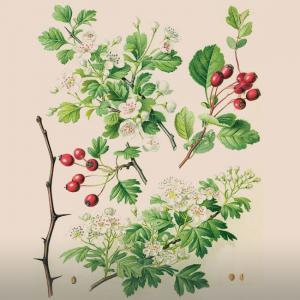
HAWTHORN BLOSSOM (CRATAEGUS LAEVIGATA) - PLANTS

BASE / GENERAL DATA
Information submited: November 21, 2017 Modified: May 15, 2018 By: OperaDreamhouse
Botanical Name: Crataegus Laevigata;
Botanical Origin: Northern Hemisphere in Europe, Asia and North America;
Part Typically Used: Flowers, leaves, fruits;
Common name: Thornapple, May-tree, Whitethorn, Hawberry;
Crataegus from the Greek Kratos "strength" and Akis "Sharp", referring to the thorns of some species.
Crataegus species are shrubs or small trees, mostly growing to 5 - 15 m tall, with small pome fruit and thorny branches. The thorns are small sharp-tipped branches that arise either from other branches or from the trunk, and are typically 1- 3 cm in one case.
Botanical Origin: Northern Hemisphere in Europe, Asia and North America;
Part Typically Used: Flowers, leaves, fruits;
Common name: Thornapple, May-tree, Whitethorn, Hawberry;
Crataegus from the Greek Kratos "strength" and Akis "Sharp", referring to the thorns of some species.
Crataegus species are shrubs or small trees, mostly growing to 5 - 15 m tall, with small pome fruit and thorny branches. The thorns are small sharp-tipped branches that arise either from other branches or from the trunk, and are typically 1- 3 cm in one case.
The leaves grow spirally arranged on long shoots, and in clusters on spur shoots on the branches or twigs. The leaves of most species have lobed or serrated margins and are somewhat variable in shape.
The fruit, sometimes known as a "Haw", is berry-like but structurally a pome containing from one to five pyrenes that resemble the "Stones" of plums, peaches, which are drupaceous fruit in the same subfamily.
The flowers has five blossoms. Hawthorn Flowers has unpleasant smell because they had chemical component trimethylamine.
The flowers has five blossoms. Hawthorn Flowers has unpleasant smell because they had chemical component trimethylamine.
Most hawthorns bloom in late May - June. When the tree blooms, it most produces a chemical element in trisethylamine. But this is a matter of smell, others like this breathtaking smell.
Hawthorn inflorescences are used in medicine as a tea or as syrup.
Hawthorn inflorescences are used in medicine as a tea or as syrup.
Believed to uplift and strengthen both the physical and emotional heart, Hawthorn, as it supports healthy cardiovascular function, was also revered for ceremonial and spiritual purposes.
Collect the flowering branches in the spring as all parts (leaves, twigs, spines, flowers) may be used for fresh tincturing. Or if drying, discard stems and spines.

SPIRITUAL PRACTISES DATA

MEDICINE / HEALTH DATA
Information submited: November 21, 2017 Modified: May 15, 2018 By: OperaDreamhouse
Therapeutic Properties:
Cardiac
Diuretic
Tonic
Sedative
Vasodilator
Astringent
Hypotensive
Cardioprotective
Contraindications: Possibly safe for most adults when used at recommended doses short-term (up to 16 weeks);
Chemical structure: Hawthorn contains around 1 - 2% flavonoids, oligomeric proanthocyanidins (1 - 3%), saponins, phenolic acids (chlorogenic acid, caffeic acid), 2 - (2-Phenylethyl)chromone derivatives (in the flowers, leaves and buds), amine (phenethylamine, metoksyfenetylamin, dopamine, acetylcholine and tyramine) and triterpenes based on ursolic acid and oleanolic acid;
Anthocyanin is found in the fruit peel and the fruit contains essential oil, pectin, Vitamin C and other substances.
The flowers contain the highest levels of flavonoids, while the leaves contain most of the oligomeric proanthocyanidins;
Pregnancy / Lactation: Because it is heart tonic you can be use in small portions for breastfeeding and in pregnancy period;
Children: Can use in a small portions;
The blossoms were used as a heart tonic and a diuretic. Hawthorn is used for diseases of the heart and blood vessels such as congestive heart failure (CHF), chest pain, and irregular heartbeat. It is also used to treat both low blood pressure and high blood pressure, “hardening of the arteries” (atherosclerosis), and high cholesterol.
Hawthorn can help improve the amount of blood pumped out of the heart during contractions, widen the blood vessels, and increase the transmission of nerve signals.
Hawthorn also seems to have blood pressure-lowering activity, according to early research. It seems to cause relaxing of the blood vessels farther from the heart. It seems that this effect is due to a component in hawthorn called proanthocyanidin.
Some people use hawthorn for digestive system complaints such as indigestion, diarrhea, and stomach pain. It is also used to reduce anxiety, as a sedative, to increase urine output, and for menstrual problems.
Cardiac
Diuretic
Tonic
Sedative
Vasodilator
Astringent
Hypotensive
Cardioprotective
Contraindications: Possibly safe for most adults when used at recommended doses short-term (up to 16 weeks);
Chemical structure: Hawthorn contains around 1 - 2% flavonoids, oligomeric proanthocyanidins (1 - 3%), saponins, phenolic acids (chlorogenic acid, caffeic acid), 2 - (2-Phenylethyl)chromone derivatives (in the flowers, leaves and buds), amine (phenethylamine, metoksyfenetylamin, dopamine, acetylcholine and tyramine) and triterpenes based on ursolic acid and oleanolic acid;
Anthocyanin is found in the fruit peel and the fruit contains essential oil, pectin, Vitamin C and other substances.
The flowers contain the highest levels of flavonoids, while the leaves contain most of the oligomeric proanthocyanidins;
Pregnancy / Lactation: Because it is heart tonic you can be use in small portions for breastfeeding and in pregnancy period;
Children: Can use in a small portions;
The blossoms were used as a heart tonic and a diuretic. Hawthorn is used for diseases of the heart and blood vessels such as congestive heart failure (CHF), chest pain, and irregular heartbeat. It is also used to treat both low blood pressure and high blood pressure, “hardening of the arteries” (atherosclerosis), and high cholesterol.
Hawthorn can help improve the amount of blood pumped out of the heart during contractions, widen the blood vessels, and increase the transmission of nerve signals.
Hawthorn also seems to have blood pressure-lowering activity, according to early research. It seems to cause relaxing of the blood vessels farther from the heart. It seems that this effect is due to a component in hawthorn called proanthocyanidin.
Some people use hawthorn for digestive system complaints such as indigestion, diarrhea, and stomach pain. It is also used to reduce anxiety, as a sedative, to increase urine output, and for menstrual problems.

BEAUTY / COSMETICS DATA

FOOD / COOKING DATA
COMMENTS
No comments.





